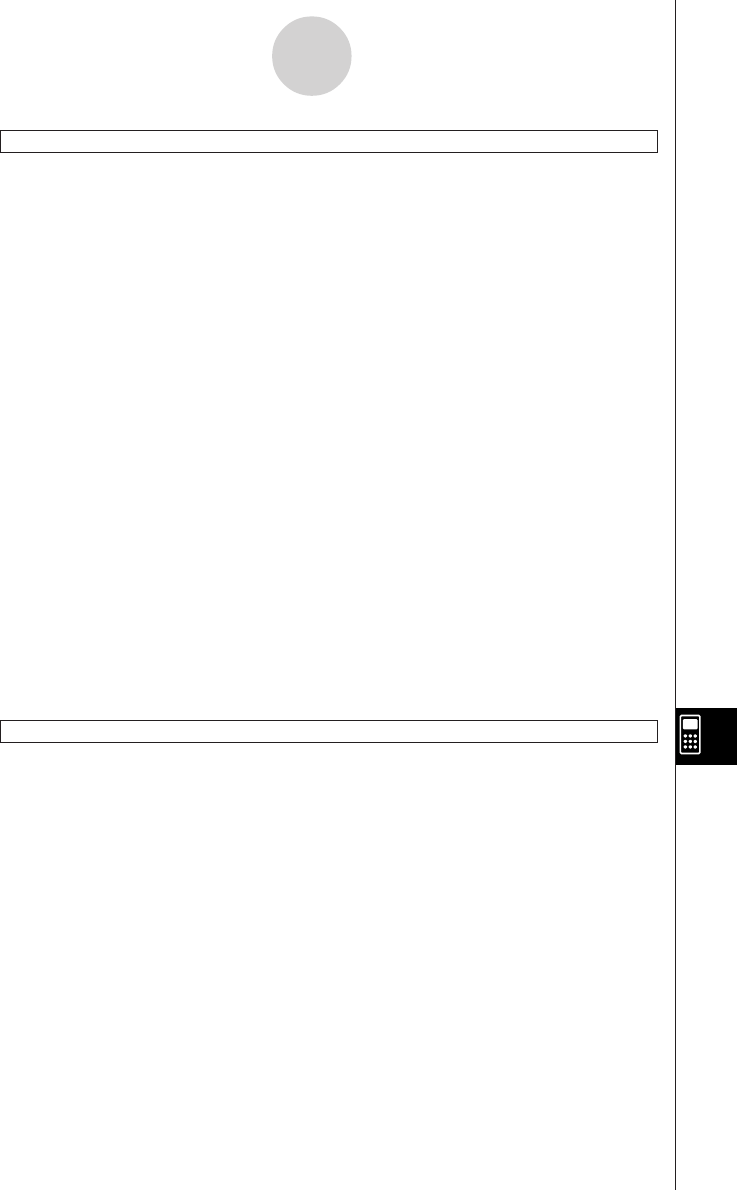User Manual
Table Of Contents
- Getting Ready
- Contents
- About This User’s Guide
- Chapter 1 Getting Acquainted
- Chapter 2 Using the Main Application
- 2-1 Main Application Overview
- 2-2 Basic Calculations
- 2-3 Using the Calculation History
- 2-4 Function Calculations
- 2-5 List Calculations
- 2-6 Matrix and Vector Calculations
- 2-7 Using the Action Menu
- 2-8 Using the Interactive Menu
- 2-9 Using the Main Application in Combination with Other Applications
- 2-10 Using Verify
- Chapter 3 Using the Graph & Table Application
- Chapter 4 Using the Conics Application
- Chapter 5 Using the 3D Graph Application
- Chapter 6 Using the Sequence Application
- Chapter 7 Using the Statistics Application
- 7-1 Statistics Application Overview
- 7-2 Using List Editor
- 7-3 Before Trying to Draw a Statistical Graph
- 7-4 Graphing Single-Variable Statistical Data
- 7-5 Graphing Paired-Variable Statistical Data
- 7-6 Using the Statistical Graph Window Toolbar
- 7-7 Performing Statistical Calculations
- 7-8 Test, Confidence Interval, and Distribution Calculations
- 7-9 Tests
- 7-10 Confidence Intervals
- 7-11 Distribution
- 7-12 Statistical System Variables
- Chapter 8 Using the Geometry Application
- Chapter 9 Using the Numeric Solver Application
- Chapter 10 Using the eActivity Application
- Chapter 11 Using the Presentation Application
- Chapter 12 Using the Program Application
- Chapter 13 Using the Spreadsheet Application
- Chapter 14 Using the Setup Menu
- Chapter 15 Configuring System Settings
- 15-1 System Setting Overview
- 15-2 Managing Memory Usage
- 15-3 Using the Reset Dialog Box
- 15-4 Initializing Your ClassPad
- 15-5 Adjusting Display Contrast
- 15-6 Configuring Power Properties
- 15-7 Specifying the Display Language
- 15-8 Specifying the Font Set
- 15-9 Specifying the Alphabetic Keyboard Arrangement
- 15-10 Optimizing “Flash ROM”
- 15-11 Specifying the Ending Screen Image
- 15-12 Adjusting Touch Panel Alignment
- 15-13 Viewing Version Information
- Chapter 16 Performing Data Communication
- Appendix

20050501
For~To~(Step~)Next
Syntax:
For
䡺
<expression 1>
S
<control variable name>
䡺
To
䡺
<expression 2>
[Step
䡺
<expression 3>]
[<statement>] …
Next
<expression 1> is the initial value, <expression 2> is the end value, and <expression 3> is
the step.
Function
Anything between the For command and the Next command is repeated for a count starting
with the initial value of the control variable and ending when the control variable reaches the
end value. Each pass causes the value of the control variable to be changed by the value
specified by the step value. The loop is terminated whenever the control variable value
exceeds the end value.
Description
•1 is used for the step if a step value is not specified.
• The initial value can be less than the end value, as long as a positive value is specified for
the step. In this case, the value of the control value is increased by the step with each
pass.
• The initial value can be greater than the end value, as long as a negative value is specified
for the step. In this case, the value of the control value is decreased by the step with each
pass.
•You can use a multi-statement command (:) in place of the carriage return to separate
statements.
• It is always a bad idea to use the Goto command to exit a For~Next loop. Not only is it
poor programming, it can cause problems due to improper termination of internal
processes used by the loop operation.
Goto~Lbl
Syntax: Goto
䡺
<label name>
Lbl
䡺
<label name>
Function: This command causes program execution to jump to a specific location.
Description
• <label name> is a text string that is subject to the same rules as variable names.
• Goto and Lbl are used in pairs. Program execution jumps from Goto to the Lbl with the
same label name. A single Lbl can be used as the jump destination of multiple Goto
commands.
• This command can be used to loop back to the beginning of a program or to jump to any
location within the program.
•An error occurs if ClassPad is unable to find a Lbl with the same label as Goto.
•Note that the # command cannot be used in a label name.
12-6-10
Program Command Reference










